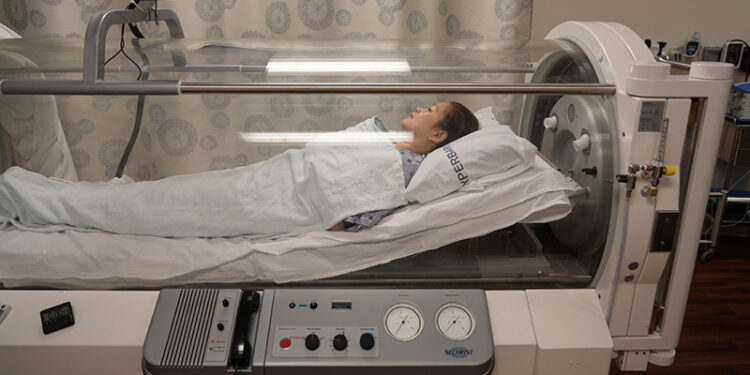Healing is often seen as a straightforward process get rest, follow a treatment plan, and wait for the body to repair itself. But what if healing could happen faster, deeper, and more completely? What if the body could receive the fuel it needs in the most powerful and efficient way possible?
That’s the idea behind Hyperbaric Oxygen Therapy (HBOT). What was once reserved mostly for divers with decompression sickness is now becoming a transformative healing tool for people recovering from wounds, injuries, inflammation, and chronic health issues. HBOT doesn’t just help the body heal—it helps the body heal better.
In this blog, we explore the incredible journey from wounds to wellness and how HBOT supports the body at every stage of recovery.
The Science Behind HBOT: Why Oxygen Matters More Than You Think
Every cell in your body needs oxygen to function. It’s the fuel for energy production, tissue repair, immune defense, and inflammation control. But when the body is injured or dealing with chronic illness, oxygen supply can become limited—especially in damaged tissues where blood flow is reduced.
Hyperbaric Oxygen Therapy changes that equation.
Inside a hyperbaric chamber, you breathe nearly 100% oxygen at increased atmospheric pressure. This environment forces oxygen into your bloodstream at levels far higher than normal.
This extra oxygen doesn’t just circulate—it dissolves into your plasma, reaches areas starved of blood flow, and supercharges your body’s healing potential. HBOT literally gives injured tissues a second chance at recovery.
Table of Contents
How HBOT Supports Wound Healing: A Deep Dive
Wounds, whether from injury, surgery, or chronic conditions like diabetes, can disrupt the body’s natural repair process. Poor circulation, infection, inflammation, or tissue breakdown can make healing slow and unpredictable.
HBOT steps in to overcome these barriers.
1. Boosting Tissue Oxygen Levels
Damaged tissues often cannot receive the oxygen they desperately need. HBOT floods these areas with oxygen-rich plasma, helping cells repair, regenerate, and function properly again.
2. Enhancing Collagen Production
Collagen is the building block of tissue repair. HBOT stimulates fibroblast activity, helping wounds close faster and stronger.
3. Fighting Infection More Effectively
Some bacteria, especially anaerobic types, cannot survive in high-oxygen environments. HBOT enhances white blood cell function and makes infections easier to control and eliminate.
4. Reducing Swelling and Inflammation
Excess swelling can restrict blood flow and slow healing. HBOT helps regulate inflammation, allowing damaged areas to recover more efficiently.
5. Supporting New Blood Vessel Growth
HBOT encourages angiogenesis, the formation of new blood vessels, which helps oxygen and nutrients reach previously damaged or compromised tissues long after treatment ends.
In short: HBOT turns a stalled healing process back into an active one.
Beyond Wound Healing: Supporting Whole-Body Wellness
The benefits of Hyperbaric Oxygen Therapy don’t stop at wound recovery. Over the years, researchers and patients have noticed improvements reaching far beyond physical injuries. HBOT works on a cellular level—which means it can improve functions throughout the entire body.
1. Faster Recovery From Sports Injuries
Athletes now widely use HBOT to bounce back from muscle strains, fractures, and overuse injuries. Increased oxygen speeds tissue repair and reduces downtime.
2. Improved Brain Function and Cognitive Support
HBOT increases oxygen delivery to the brain, supporting neuroplasticity, reducing inflammation, and helping patients recovering from concussions, strokes, and neurological issues.
3. Reduced Chronic Inflammation
Chronic inflammation is linked to fatigue, pain, autoimmune issues, and premature aging. HBOT helps the body regulate inflammation more effectively.
4. Enhanced Energy and Immune Response
More oxygen means more cellular energy. Many people experience better stamina, stronger immunity, and improved resilience after a series of HBOT sessions.
5. Promoting Anti-Aging and Longevity
Some studies show HBOT may lengthen telomeres (the protective caps on DNA), potentially slowing cellular aging. Combined with better blood flow and reduced inflammation, it’s becoming a popular therapy for those prioritizing long-term wellness.
A Holistic Journey: From Injury to Strength
One of the most remarkable aspects of HBOT is how it supports both recovery and well-being. It’s not just about treating wounds—it’s about giving the entire body an environment where healing becomes easier, faster, and more complete.
Patients often report:
- more energy
- improved mental clarity
- reduced pain
- better sleep
- deeper sense of wellness
That’s because HBOT doesn’t simply fix a problem—it rebuilds the foundation of health from the inside out.
Who Can Benefit From HBOT?
Hyperbaric Oxygen Therapy is commonly used for:
- diabetic or chronic wounds
- surgical recovery
- traumatic injuries
- radiation damage
- infections
- sports injuries
- neurological recovery
- inflammation-related conditions
However, many wellness-focused individuals choose HBOT proactively to boost overall vitality and resilience.
Always consult with a healthcare provider to see if it’s right for your specific goals or conditions.
Final Thoughts: Healing Beyond the Surface
The journey from wounds to wellness isn’t always easy, but Hyperbaric Oxygen Therapy has opened a new path—one where healing is accelerated, energy is restored, and the body gains what it needs to thrive.
HBOT shows us that recovery isn’t just about time passing.
It’s about giving the body the right tools, the right environment, and the right support.
From chronic wounds to chronic inflammation, from injuries to long-term wellness goals, HBOT offers a powerful, science-backed way to help the body rebuild, rejuvenate, and rise stronger than before.
If you’re seeking a therapy that works with your body—not against it—Hyperbaric Oxygen Therapy may be the next step on your journey to better health.


 Home
Home










